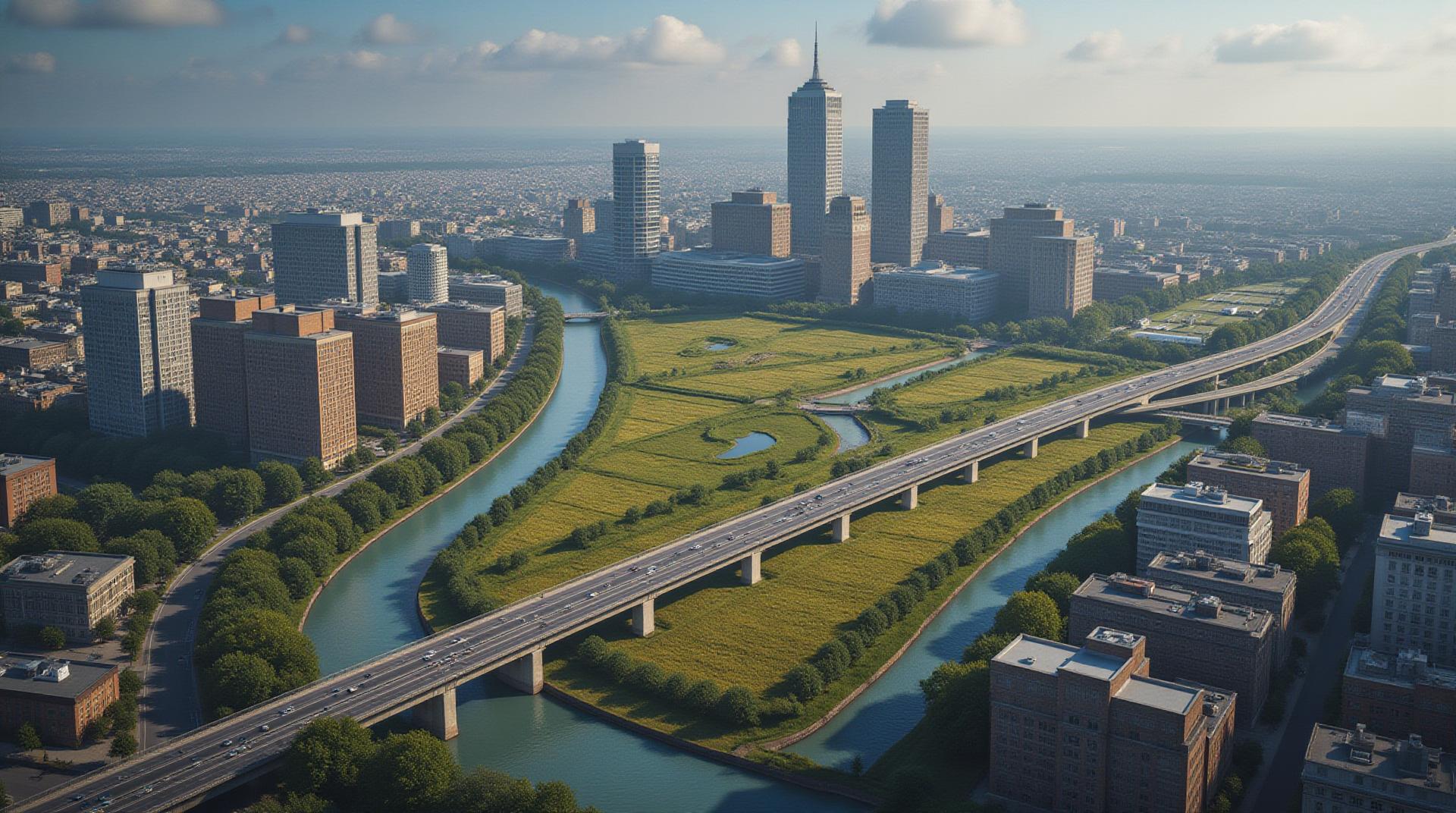GeoAI for Smart Infrastructure Planning – Urban Development
GeoAI for Smart Infrastructure Planning – Urban Development
In the ever-evolving landscape of urban development, the future hinges on how efficiently and sustainably our cities are built. At the forefront of this transformative approach lies the utilization of GeoAI (Geo-Intelligence Artificial Intelligence), revolutionizing infrastructure planning and contributing significantly to the techno-optimisation of resource allocation and management within urban ecosystems.
GeoAI equips urban planners and developers with unprecedented capabilities to leverage the benefits of spatial data, machine learning, and deep learning. This comprehensive integration of artificial intelligence empowers stakeholders to address inefficiencies and challenges in building sustainable cities, promoting their development in an environmentally and economically sound manner.
Key Features of GeoAI for Smart Infrastructure Planning
* **Predictive Analytics:** GeoAI utilizes advanced algorithms to analyze existing and historical data on factors like population growth, travel patterns, environmental conditions, and socioeconomic trends, enabling dynamic predictions of future infrastructure needs.
* **Smart Resource Allocation:** By pinpointing the most strategic locations and optimizing the density of infrastructure projects, GeoAI significantly enhances resource utilization, thereby reducing waste and fostering intelligent urban developments.
* **Optimized Infrastructure Design:** With advanced visualization tools and augmented realities (AR), GeoAI facilitates the accurate assessment and design of infrastructure projects. This includes optimizing traffic flow, enhancing public transportation networks, minimizing environmental impact, and improving building energy efficiency.
* **Disaster Preparedness and Response:** GeoAI plays a vital role in disaster preparedness and response by simulating potential risks, providing early warnings, aiding evacuation planning, and optimizing emergency services deployment in dynamic urban environments.
Benefits of GeoAI for Urban Development
* **Enhanced Efficiency and Cost-effectiveness:** By streamlining infrastructure projects through accurate predictions and optimized designs, GeoAI reduces project time, lowers construction costs, and improves project predictability.
* **Reduced Environmental Impact:** GeoAI can identify areas susceptible to environmental pressures and guide land-use decisions that minimize carbon emissions, enhance biodiversity, and promote sustainable urban development.
* **Improved Public Safety:** Smart infrastructure solutions powered by GeoAI enhance public safety through efficient traffic management, improved emergency response times, and optimized public transport systems, thereby promoting a safer and more inclusive urban environment.
* **Data-Driven Planning and Decision-Making:** GeoAI provides vital data insights, enabling urban developers, policymakers, and residents to make better-informed decisions about city planning, infrastructure improvements, and resource management.
Practical Applications of GeoAI in Urban Development
* **Urban Mobility Optimization:** GeoAI-powered transportation planning systems can optimize traffic flow by analyzing real-time traffic conditions and dynamically adjusting traffic signals. This results in improved congestion management, reduced travel times, and cleaner air quality.
* **Smart Waste Management:** GeoAI intelligently analyzes waste generation patterns and optimizes waste collection routes, helping reduce landfill waste and promote recycling initiatives.
* **Renewable Energy Integration:** GeoAI facilitates the integration of renewable energy sources by accurately mapping areas with optimal sun exposure, wind resource potential, and integrating solar farm and wind farm sites into the urban fabric of cities.
* **Smart Grid Development:** GeoAI optimizes power grid infrastructure by analyzing usage patterns and resource availability, contributing to a more efficient and resilient power grid that minimizes energy waste and optimizes energy allocation.
Diving Deeper into GeoAI Resource Hubs
The growing expanse of GeoAI applications within Urban Development opens a vast array of interactive websites and tools you may explore.
- AI for Urban Development & Climate Action : Offers valuable information about the use of AI in urban planning, promoting sustainable development.
[https://www.ai4urbandevelopment.com/](https://www.ai4urbandevelopment.com/) - Planet Scale: Development & Growth Management : A platform that highlights innovative solutions for sustainable infrastructure development.
[https://planet-s.ee/solutions/](https://planet-s.ee/solutions/) - The Geospatial Vision Project : Project dedicated to expanding the use of geospatial technologies in urban development.
[https://thegeospatialvision.org/](https://thegeospatialvision.org/)
GeoAI emerges as a transformative force in urban development, empowering us to design smarter, more resilient, and sustainable cities.
Check similar topics:
GeoAI Infrastructure Planning FAQs
This section answers your common questions about GeoAI infrastructure planning.
What is GeoAI Infrastructure Planning?
GeoAI Infrastructure planning is the systematic process of designing, building, and managing the technology infrastructure needed for successful GeoAI implementation. It outlines the resources, software, and hardware required for organizations to utilize Machine Learning models for geographic data.
Availability
GeoAI infrastructure planning is available on almost all platforms. Our system is designed to be flexible, allowing for adaptation to different cloud environments, on-premises deployments, and hybrid options.
Formats
GeoAI infrastructure planning works well with multiple data formats. Some commonly supported formats include:
- Geospatial Data Products (such as shapefiles, GeoJSON, KML): These contain spatial information across geographic areas and landscapes
- Sensor Data (such as Lidar or satellite imagery): These provide direct measurements and visuals of the environment and geographic features.
- Relational Databases (such as PostgreSQL, MongoDB) Used to store data elements that will be part of your geospatial analysis
Usage
GeoAI infrastructure planning is designed to offer the following key functionalities:
- Data Acquisition and Integration
- Data Manipulation and Pre-processing
- Model Training and Development
- Deployment Optimization
- Model Monitoring and Deployment
Learn More about GeoAI Infrastructure Planning
Why is GeoAI Infrastructure Planning Important?
GeoAI infrastructure planning lays the foundation for efficient and impactful GeoAI applications by:
- **Ensuring Scalability:** Adapts to an expanding amount and types of data and computationally intensive models.
- **Enhances Data Management:** Improves data storage, organization, quality, add control over data, and automates its flow.
- **Facilitates Rapid Development:** Offers solutions for faster prototyping, faster model training and deployment.
Actionable Insights
By implementing strong GeoAI Infrastructure Planning, organizations have a strategic foundation for tackling complex geospatial challenges, from optimizing resource allocation and environmental management to predicting disaster risks.
Onuit’s GeoAI Infrastructure Planning provides tailored solutions for your organization, and we offer:
- Assessment and Gap Analysis
- Infrastructure Design
- Framework Development
- Monitoring and Optimization
Contact us to discover the potential of GeoAI for your business!

